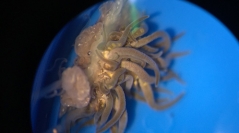

 Cryptogamie, Algologie
40 (8) - Pages 85-94
Cryptogamie, Algologie
40 (8) - Pages 85-94The dinoflagellate Symbiodinium sp. establishes symbiotic relationships with the anemone Exaiptasia diaphana Rapp. The process that leads to the reciprocal recognition of the two symbiotic partners is still not very well understood. We hypothesize that chemical signals are exchanged between the Exaiptasia diaphana-Symbiodinium holosymbiont and aposymbiotic anemones or between free living Symbiodinium and holo- and aposymbiotic Exaiptasia, leading to changes in organic and elemental compositions in the aposymbiotic anemones. In order to test these hypotheses, bleached anemones were exposed to the presence of either free living Symbiodinium, previously extracted from the same Exaiptasia clone, or to holobionts. The ex-hospite algae and the holobionts were included in dialyses membranes with a cut-off of 14 000 Da. In the control treatments, the experimental samples were exposed to the presence of empty dialysis tubes. The organic composition and the elemental composition of the anemones were determined by Fourier Transform Infrared Spectroscopy and Total Reflection X-Ray Fluorescence Spectroscopy/Gas Chromatography, respectively. The fact that both the organic and elemental composition of the experimental aposymbiotic anemones differed significantly from the controls, in the absence of any obvious nutritional effect, is suggestive of an exchange of chemical signals between the aposymbiotic and holosymbiotic anemones.
Cell composition, elemental stoichiometry, FTIR, infochemicals, symbiosis